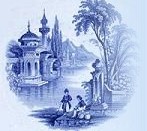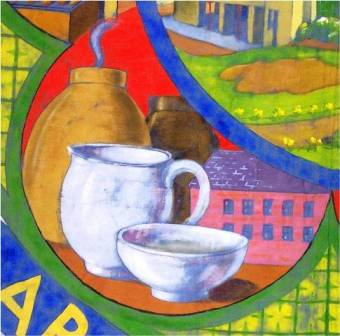




WILLIAM WOOLLISCROFT
The following article was researched and written by Belleek Pottery enthusiast, Paul Tubb. Paul researched William Woolliscroft
because of his Belleek connection, however, there is a short connection with Bo'ness.
Many potters of the 19th century had to move around the country looking for work and this article gives a great insight into the life of a
potter who did a great deal of travelling to find work to enable him to support his family.
This article first appeared in the UK Belleek Collectors' Group 2008 Newsletter. The entire Newsletter containing the original article can
be viewed online at Newsletter Number 29/1, April 2008
WILLIAM WOOLLISCROFT - ITINERANT POTTER?
As recorded elsewhere in this newsletter, we obtained from Joyce House, Dublin the certificate for Ebeneezer Swann’s marriage to Eliza
Guest in 1871 and this has led us to another potter who went from Stoke on Trent to Belleek, namely William Woolliscroft. The link is
that William’s daughter, Elizabeth Woolliscroft, is one of the witnesses to Ebeneezer and Eliza’s wedding. We are aware that
Woolliscroft with its variants is a common enough name in the area of the Potteries in England so we set out to discover more about
them.
The other witness was a Matthew Henry Pope and he will feature in a further article in the series in due course. Pope, of course, is one
of the names given in the three lists of Staffordshire men who went to Belleek in the 1860s. However, just like the Astley brothers,
William Woolliscroft is not named in those lists and neither, of course, is his daughter although she may have also worked in the pottery
at Belleek as may her brother John, who in later years is recorded in the UK censuses as a mould maker like his father.
Whilst researching the family we have discovered that William and his wife, Mary Anne, had four children born in Scotland as well as
two born in Ireland which, added to those born in Stoke on Trent, shows parents willing to take their young family around the British Isles
to find work and hence provides the title for this particular article about the family. We cannot be sure at which potteries William worked
in Scotland but the four children were born, one in Fife, two in Glasgow and the youngest in Bo’ness. The three youngest of the
‘Scottish’ children were, consecutively, the sixth, seventh and eighth in the family but Jessie, born in the Dysart district of Fife during
1857, was the third and had two older siblings and two younger siblings born in Stoke on Trent. The ‘Irish’ children were the youngest
two of the ten children.
William had been born in Hanley in 1830 and was the son of another William and his wife Elizabeth [nee Robson]. Of his siblings only
his brother, Joseph, survived into adulthood but we have been unable to ascertain any further information on Joseph during our
researches. William married Mary Ann Price at the Chapel of Hanley on August 26th 1850. He is noted as a Potter living in Union Street
and Mary Ann has no occupation given but was living in Dale Street. Her father, David Price, is said to be a wheelwright and William’s
father is called a Farmer.
Their eldest child, Elizabeth, was born the following year on November 7th 1851 and their first son, John, came along in the summer of
1854. The address for the family on Elizabeth’s birth certificate is Union Street, Hanley and the father’s occupation is recorded as
Potter’s Mould Maker.
As noted earlier, the family were in Fife for the birth of Jessie in 1857 but back in Stoke on Trent when Ellen was born in the autumn of
1859 followed by William two years later. In 1857 Robert Heron was producing Wemyss Ware from the Fife Pottery in Kirkcaldy and the
Links Pottery [Methven’s] was also in production in the town so that William might have worked for one or the other.
At the time of the 1861 census the family are recorded living at 2 Austin Buildings, Well Street in Hanley and the father, William, is a
Mould Maker. Interestingly, he seems to have also been recorded in the Scottish census return for Alloa on the same day, where his
occupation is that of Moulder & Mould Maker but his relationship to the head of the household is given as Travler [sic] and his birthplace
as England. The most likely explanation for this dual recording is that he was, indeed, in Alloa at the time of the census in early April but
his wife recorded him in the family home because that was his usual residence when he was not away ‘travelling’ to find work. There is
no way of verifying this surmise and the two entries could refer to two different William Woolliscrofts of the same trade and age but, in
our opinion, this is unlikely with a name as relatively uncommon, at least in Scotland, as Woolliscroft. The Alloa Pottery in Kirkgate,
Alloa was in production at this time and William may have been investigating the prospects of work in that concern.
Following young William’s birth the family moved to Scotland where Joseph was born on January 10th 1864 at 21 Oak Street, Glasgow
followed by Mary Anne on April 12th 1866 at 6 Stackpole Place, Glasgow and Grace born on August 13th 1867 at McNair’s Lane, North
Street, Bo’ness. On the first certificate the father is noted as a journeyman potter but on the final two he is referred to as a Pottery
Modeller. There are so many potteries operating in the Glasgow area at this time that it is quite impossible to ascertain at which of them
William might have been employed.
But, in Bo’ness, there was only one pottery operating in 1867, the Bo’ness Pottery, which operated from 1766 to 1898 under various
owners and using a variety of trading names. Robert Jardine runs a website about the Bo’ness Potteries and has been generous with
help for this article. It would appear that, at the time William was working there, the works were being owned and managed by John
Marshall and William McNay.
There is no sign of our William and his family in the 1871 census returns for England or Scotland, but we know that they were all over in
Fermanagh because their last son, Arthur, was born in Belleek on April 8th 1870 and his sister, Frances, was born there on May 3rd
1871 whilst the oldest daughter, Elizabeth, was witness to Ebeneezer Swann’s marriage to Eliza Guest on October 2nd 1871. From the
dates of birth of the children it would seem likely that William brought his family over to Belleek at some time in 1869 but whether they
had moved back to the potteries in England before coming to Ireland or set off from Scotland directly we cannot, at this stage ascertain.
What does seem clear is that William was content to move his young family around the British Isles in search of a livelihood and it is a
tribute to him and his wife Mary Ann that all ten children reached adulthood despite their numerous long distance house moves.
William’s eldest daughter, Elizabeth, married Patrick Stephens on October 11th 1873 at Northwood in Hanley, so the supposition is that
the family were back in Hanley by then. They are certainly listed there in the 1881 census living at 97 Prime Street, Northwood, Hanley
with seven of the children still living at home with their parents. The three oldest are the missing ones and Elizabeth’s marriage has
already been noted. However there is no sign of her in the 1881 census nor, indeed, of her husband. Of the seven left at home, Ellen
and Grace are noted to be working as Paintresses whilst William and Joseph are Potters. The father is, as usual, recorded as a
Potters Mould Maker. Mary Ann has no occupation listed and the two youngest are still ‘scholars’.
The other two older children are not far away. John is living at 69 Rose Street, Northwood, Hanley with his wife, Martha [formerly Wilcox]
and their five month old daughter Elizabeth. John, like his father, is working as a Potters Mould Maker. Jessie, too, is married to William
Wood, a Glost Placer born in Bucknall, but is living even closer, lodging at 93 Prime Street with their two children, Alfred aged 1 and
Mary Ann just four months old. At this time Prime Street was on the very edge of the Northwood area of Hanley with lovely views
eastwards over the Staffordshire hills.
By the time of the next census in the spring of 1891 William and Mary Ann are still at 97 Prime Street so it would appear that their
wandering days are over which indicates that William had found regular employment as a Potter’s Mould Maker. As usual there is no
indication in the census return as to which pottery company employed him. The sons, Joseph and Arthur, have followed their father as
Mould Makers and are both unmarried and still living with their parents. None of the other children remain in the household but most of
them are still in the potteries area.
As mentioned earlier Elizabeth married Patrick Stephens in 1873 but thereafter is missing from all UK records indicating that the pair of
them probably either went back to Ireland or went even further to America/Canada or Australia/New Zealand. We have found no record
of them in the US census returns so far.
John, however, remained in Stoke with his wife Martha and their family of five children. They are living at 91 Victoria Street, Hanley and
have Martha’s father, Job Wilcox a coalminer, living with them. Job had been born in Somerset and two of John and Martha’s children
were also noted as having been born near Bath. Why the family had relocated to near Bath in the mid 1880s can only be surmised as
Job himself had come to the potteries early in life and married a girl from Penkhull.
Jessie’s whereabouts have proved impossible to discover in the 1891 census. Neither she nor William nor the two children are indexed.
Ellen married a William Cooper in the summer of 1886 and is either living in Reservoir Road, Longton or at 68 Bolam Street, Byker,
Northumberland. Both possible husbands are working in the pottery industry and without buying a birth certificate for one of the children
it is impossible to be certain which Ellen and William Cooper is the right one.
William is much easier to trace as he is lodging at 38 Vincent Street in the house of Thomas Leat. His occupation is given as a Potters
Placer. He married Eleanor Healey in the summer of 1900 and they are listed as living at 20 Gate Street, Hanley in the 1901 census
from which we also discover that Eleanor was originally from Carlisle in Cumberland and was then employed as a Potter’s Thrower. The
next brother, Joseph, is living at home with his parents.
Mary Ann married William Smallwood in the summer of 1888 and is living at 16 Victoria Road, Fenton at the time of the census. The
couple have no children and William is noted as a Potters Placer whilst Mary Ann is a Dressmaker. From further investigation we have
discovered that Mary Ann died in the early part of 1892 and we think it was in connection with the birth of her only child, a daughter
Gertrude, who is living with her father and his parents at 42 Victoria Road, Fenton at the time of the 1901 census return.
We have found no sign of Grace in this census but she had married early in 1887 to either a James Bentley or an Edward Barnett.
Without buying the marriage certificate or finding Grace on the census index it is impossible to say which man she married.
Arthur, as we have seen, is still at home with his parents in 1891 and, we think, he married a Mary Evans in the autumn of 1895. They
are recorded in the 1901 census as living at 12 East View, Hanley with their 3 year old daughter Edith. Arthur is noted as a Potters
Mould Maker and was born in Ireland whilst his wife hails from Flintshire.
This just leaves Frances to be accounted for and she is living with her husband, Richard Walters, whom she married in the summer of
1890, at 81 Moston Street, Hanley. She is described as a Dressmaker, like her sister, and Richard is a Potter’s Flower Painter and he
was born in Fenton. As for Frances, her birthplace is given as Ireland with Belleek crossed out and replaced with what looks like Belfast
in another hand altogether. Perhaps the enumerator or the checker had never heard of Belleek and so assumed that Richard had spelt
Belfast wrongly!!
To return, finally, to William who had taken his young family over to Belleek in the late 1860s he would, we are sure, have been proud of
the success his children made of their lives and would, as time went on, feel that his moving them around to Scotland and Ireland had
probably not affected them adversely in the end. He finally settled in Northwood and many of his children stayed close and would have
been near enough to console each other when William died on May 17th 1897 aged 67. The informant of the death is his son, Joseph,
who by then was living at 91 Victoria Street whilst William’s place of death is recorded as 124 Prime Street. Their mother, Mary Ann,
had died in the autumn of 1892 aged 64.
If you ever get the chance again to go with Fergus Cleary into the Mould room at Belleek, as we did two summers ago, let your
imagination run riot and think which of the old moulds William Woolliscroft or Sam Scarlett might have actually made. If only the moulds
could talk, what a tale they might tell!!
Finally we would like to record our thanks to Jill Dixon, of the Woolliscroft One Name Study, for her response to our request for
information and to Margaret Wilson from Australia whom we contacted via Rootsweb who also has information on the family. As
mentioned in the text, Robert Jardine has helped with information about the Bo’ness Pottery and our own David Reynolds has provided
invaluable information regarding the Scottish Pottery companies within which William Woolliscroft may have plied his trade.
Other references used:
UK census returns via www.ancestry.com
UK BMD indexes via FreeBMD web site
1883 Ordnance Survey Map of Northwood
Irish BMD indexes from GRO Research Centre, Dublin.
Scottish BMD indexes through www.scotlandspeople.gov.uk